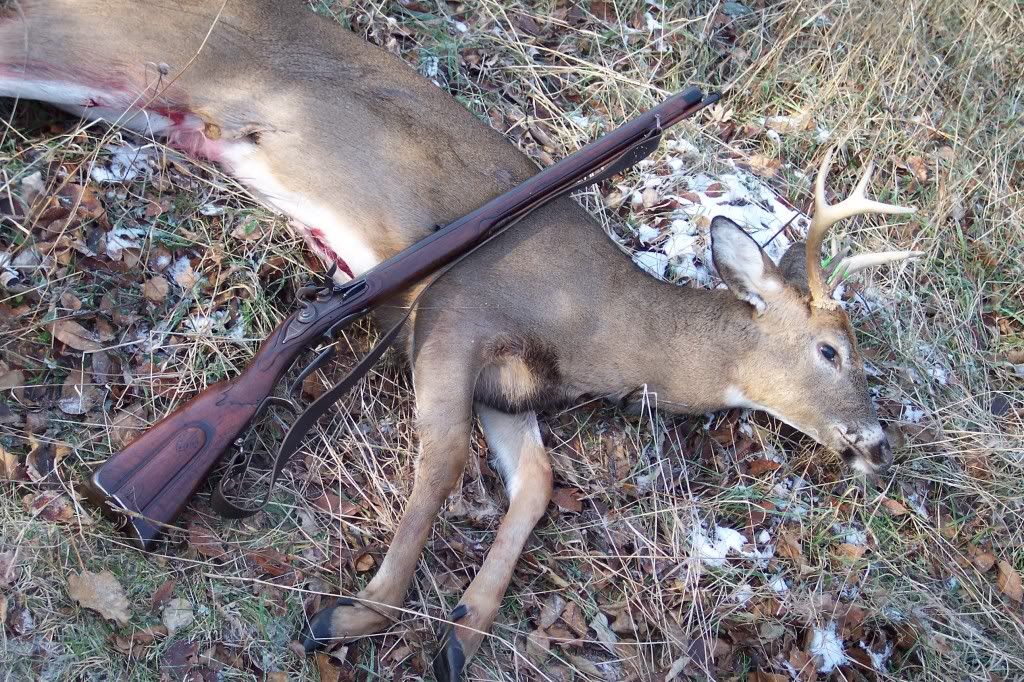Stophel
75 Cal.
- Joined
- Jul 8, 2005
- Messages
- 5,949
- Reaction score
- 859
Here are some old guns.
www.photobucket.com/albums/v326/Fatdutchman/Original Flintlocks/SpanishStyle
www.photobucket.com/albums/v326/Fatdutchman/Original Flintlocks/GermanRifle
www.photobucket.com/albums/v326/Fatdutchman/Original Flintlocks/GermanFowler
The first gun is mine. A super light smoothbore gun about .50 caliber. Early 18th century, say, 1720. The only thing I have that is still original flint. Although this gun is well used, it was not abused. It has a wonderfully original wood surface, which is a great thing for a gunmaker to see. All the beautiful scraper marks. :wink:
The second gun is a rifle from about 1760. Super neat hardware. The conversion was done in Germany. When this gun was "found", it was completely covered in black paint!
The last gun is a ca. 1760 bird gun that is currently not in the greatest state (an unfortunate condition for a great many old guns). It has a bayonet trap in the buttplate (wish I had the bayonet...and the forward two feet of barrel, which were cut off...), which was a minor fad in the 18th century. It was per-cussed in Germany. When I got it, it was badly "reconverted" with Siler parts. I have begun a more proper reconversion, but it is way on the back burner now. I got the gun cut down, with an underrib screwed to the bottom of the barrel. I don't know if this little bit of engineering was done in Germany or America.
These are all nice, but still "average grade" guns. None would be considered "royal quality", though the last bird gun would come closest. I have photos of another gun that is obviously made by the same maker as this one. It is a full stock gun, that I believe is straight rifled. The lock is from Liege, and is probably a mass produced commercial lock bought by the stocker, as would likely be the engraved brass hardware. It's in nicer shape than my gun...
I also have a ca. 1830 German rifle with a 16" barrel, that I don't have up on my photo album. I'll have to put that one up. :wink:
www.photobucket.com/albums/v326/Fatdutchman/Original Flintlocks/GermanRifle
www.photobucket.com/albums/v326/Fatdutchman/Original Flintlocks/GermanFowler
The first gun is mine. A super light smoothbore gun about .50 caliber. Early 18th century, say, 1720. The only thing I have that is still original flint. Although this gun is well used, it was not abused. It has a wonderfully original wood surface, which is a great thing for a gunmaker to see. All the beautiful scraper marks. :wink:
The second gun is a rifle from about 1760. Super neat hardware. The conversion was done in Germany. When this gun was "found", it was completely covered in black paint!
The last gun is a ca. 1760 bird gun that is currently not in the greatest state (an unfortunate condition for a great many old guns). It has a bayonet trap in the buttplate (wish I had the bayonet...and the forward two feet of barrel, which were cut off...), which was a minor fad in the 18th century. It was per-cussed in Germany. When I got it, it was badly "reconverted" with Siler parts. I have begun a more proper reconversion, but it is way on the back burner now. I got the gun cut down, with an underrib screwed to the bottom of the barrel. I don't know if this little bit of engineering was done in Germany or America.
These are all nice, but still "average grade" guns. None would be considered "royal quality", though the last bird gun would come closest. I have photos of another gun that is obviously made by the same maker as this one. It is a full stock gun, that I believe is straight rifled. The lock is from Liege, and is probably a mass produced commercial lock bought by the stocker, as would likely be the engraved brass hardware. It's in nicer shape than my gun...
I also have a ca. 1830 German rifle with a 16" barrel, that I don't have up on my photo album. I'll have to put that one up. :wink:
Last edited by a moderator:










